Extraction with Immediate Implant Placement in Full-Arch Indications
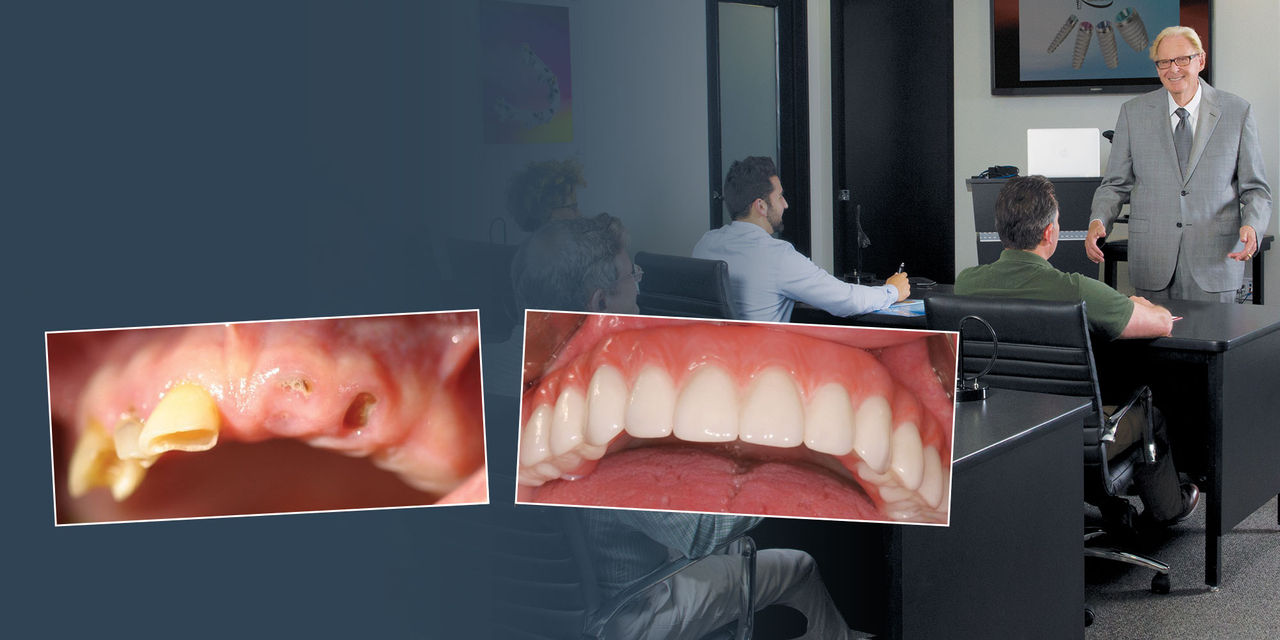
Note: The Hahn Tapered Implant System is now known as the Glidewell HT Implant System
Patients who present with terminal dentition commonly suffer from discomfort, poor dental function and low self-esteem as a result of their condition. Immediate implant placement is a treatment option that offers instant, life-changing benefits for these patients while setting the stage for a predictable long-term outcome. In the presence of sufficient bone quality and volume, after atraumatically extracting the patient’s teeth, implants can be placed and a temporary appliance delivered, allowing the patient to walk out of the office with dramatically improved form and function in one appointment. This immediately enhances the patient’s quality of life and provides a significant “wow” factor for your practice.
To establish the foundation needed for a screw-retained restoration and avoid fracturing the facial plate, clinicians must position the immediately placed implant against the lingual or palatal wall of the extraction socket. This is one of the reasons I designed the Hahn™ Tapered Implant (Glidewell Direct; Irvine, Calif.) with deep, sharp threads, which enable precise directional control during insertion and prevent the implant from “walking” toward the facial plate as it is threaded into place. This thread design also leads to high primary stability in all bone types, which is essential when performing the extraction with immediate implant placement procedure.1,2
Once osseointegration is complete, the BruxZir® Full-Arch Implant Prosthesis is the ideal choice for the restoration, as its monolithic construction prevents chips, stains, breakage, and dislodged or worn-down prosthetic teeth.3,4 This treatment option has helped elevate the quality of care I’m able to provide for my edentulous patients, who no longer return to my office with a broken acrylic appliance in hand.
The following case demonstrates how to immediately place implants in full-arch indications. By properly positioning the implants, maximizing primary stability and providing the most durable restoration possible, the short- and long-term needs of the patient are addressed in an efficient, predictable manner.
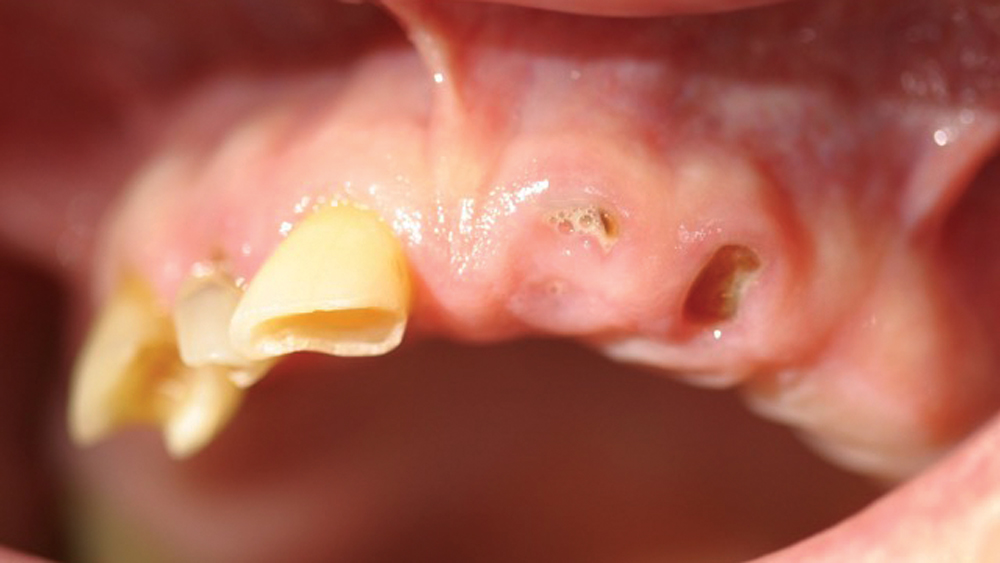
Figures 1a, 1b: The patient sought treatment for a combination of missing teeth and dentition compromised by severe decay and fractures. With an unfavorable prognosis for salvaging his remaining teeth, the patient, who didn’t want a removable denture, agreed to a treatment plan in which dental implants would be immediately placed to support fixed full-arch implant restorations. Immediate dentures were fabricated in advance of the surgical appointment.

Figures 1a, 1b: The patient sought treatment for a combination of missing teeth and dentition compromised by severe decay and fractures. With an unfavorable prognosis for salvaging his remaining teeth, the patient, who didn’t want a removable denture, agreed to a treatment plan in which dental implants would be immediately placed to support fixed full-arch implant restorations. Immediate dentures were fabricated in advance of the surgical appointment.
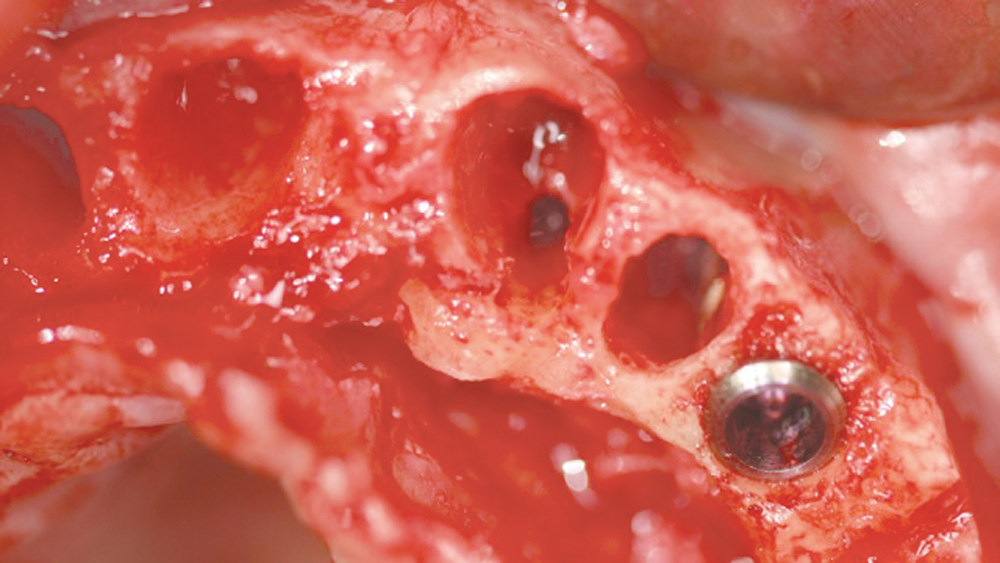
Figures 2a, 2b: After atraumatic extraction of the patient’s remaining upper teeth, osteotomies were created for six Hahn Tapered Implants. As the implants were inserted into the extraction sockets, their sharp, angled threads firmly engaged the palatal wall, preventing the implants from drifting toward the facial. Note the safe distance between the implants and the buccal aspect of the extraction sockets. This was crucial for avoiding fracture of the facial plate as well as situating the implants in proper position for a screw-retained restoration. The gaps between the implants and the facial plate were filled with Newport Biologics™ Mineralized Cortico/Cancellous Allograft Blend (Glidewell Direct).
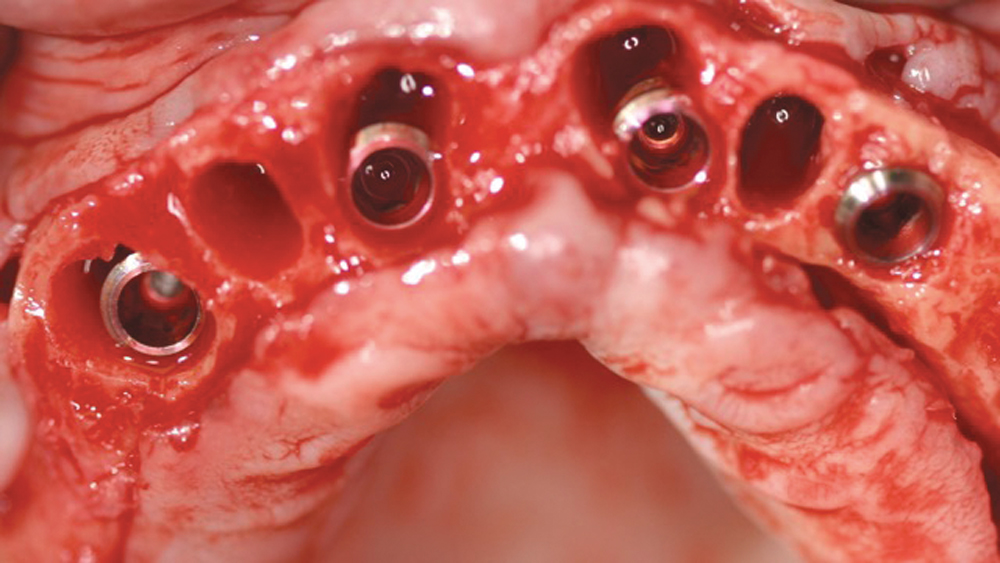
Figures 2a, 2b: After atraumatic extraction of the patient’s remaining upper teeth, osteotomies were created for six Hahn Tapered Implants. As the implants were inserted into the extraction sockets, their sharp, angled threads firmly engaged the palatal wall, preventing the implants from drifting toward the facial. Note the safe distance between the implants and the buccal aspect of the extraction sockets. This was crucial for avoiding fracture of the facial plate as well as situating the implants in proper position for a screw-retained restoration. The gaps between the implants and the facial plate were filled with Newport Biologics™ Mineralized Cortico/Cancellous Allograft Blend (Glidewell Direct).
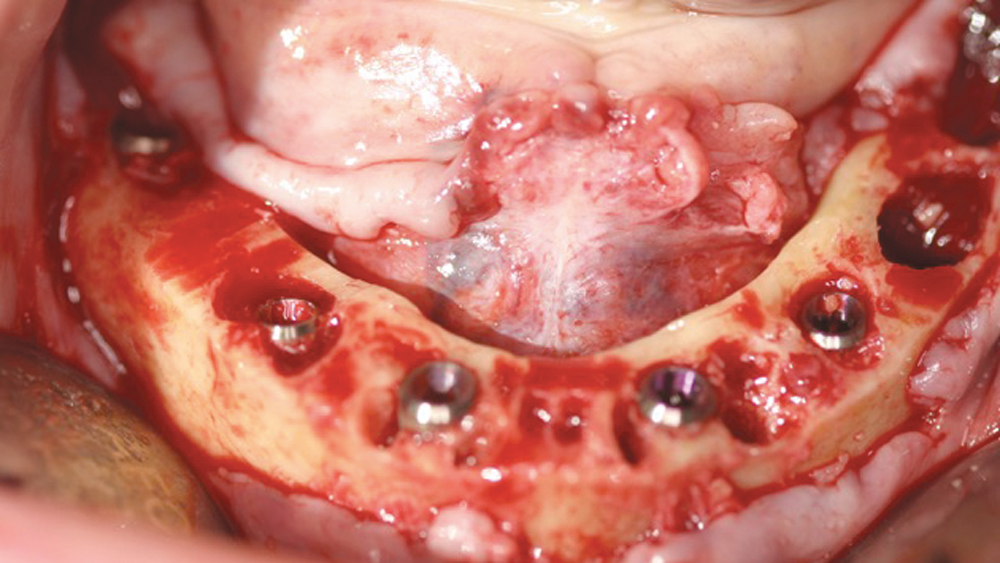
Figure 3: Seven Hahn Tapered Implants ranging from 3.5 to 5.0 mm in diameter were placed in the lower arch. Note that in order to create sufficient restorative space for the full-arch BruxZir restorations, which require a minimum of 10 mm of vertical clearance, an alveolectomy was performed to reduce the height of the maxillary ridge between teeth #5–12 by 5 mm and the height of the mandibular ridge by 8 mm. It was determined that this additional vertical space was needed by seating the immediate dentures in the patient’s mouth following teeth extraction and comparing the smile line with the teeth showing prior to treatment.
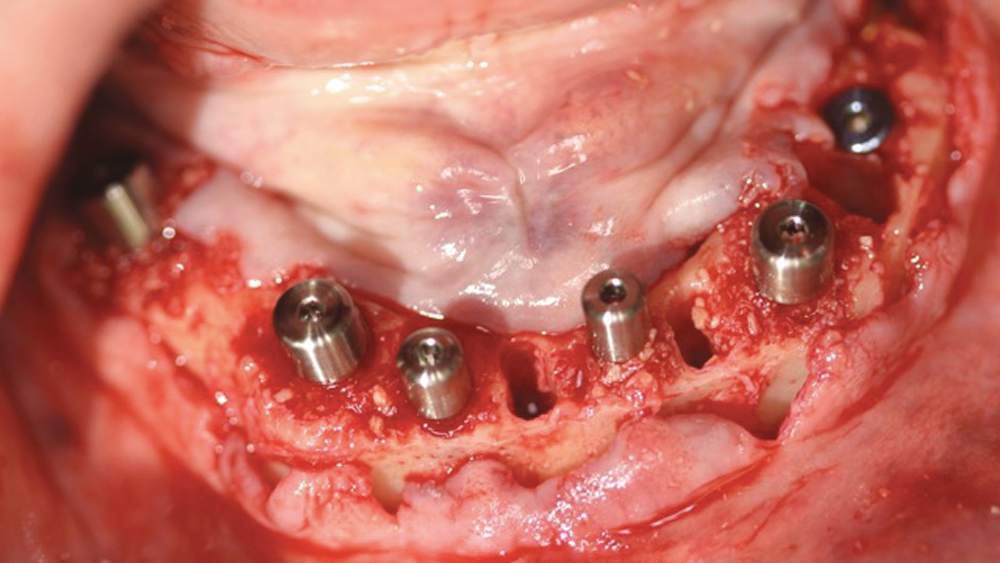
Figures 4a, 4b: Because high primary stability of 45 Ncm was achieved for each implant, healing abutments were placed. Immediate dentures were soft-relined to seat over the healing abutments, which helped retain and stabilize the temporary prostheses. The patient was very happy to leave the appointment with implants and functional appliances in place on the same day his teeth were extracted.
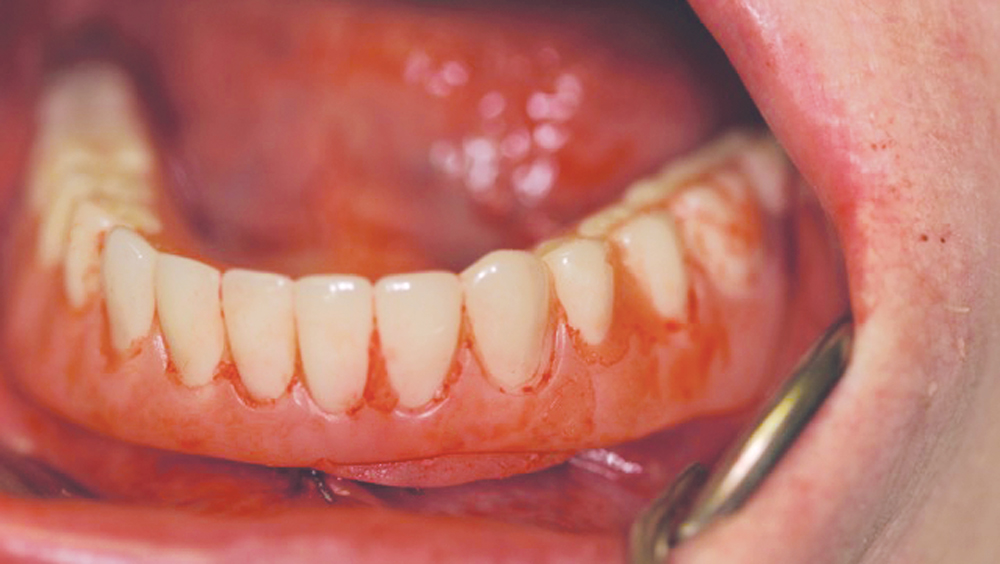
Figures 4a, 4b: Because high primary stability of 45 Ncm was achieved for each implant, healing abutments were placed. Immediate dentures were soft-relined to seat over the healing abutments, which helped retain and stabilize the temporary prostheses. The patient was very happy to leave the appointment with implants and functional appliances in place on the same day his teeth were extracted.
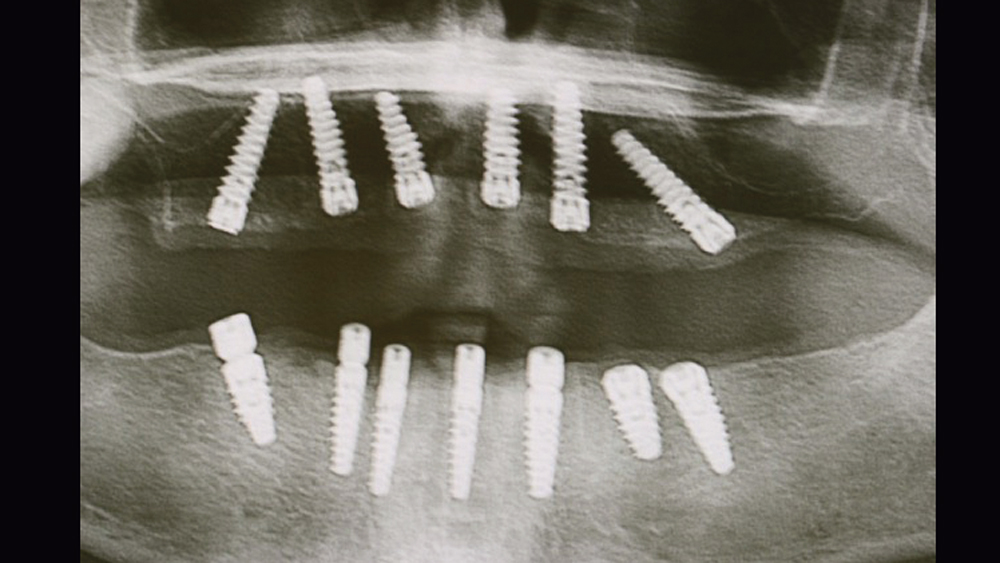
Figure 5: Panoramic radiographic view of implants in final position. The tapered shape and wide range of lengths and diameters offered by the Hahn Tapered Implant System helped ease positioning within the available bone of each arch and establish the anterior-posterior spread needed to support a fixed restoration and minimize cantilevers.
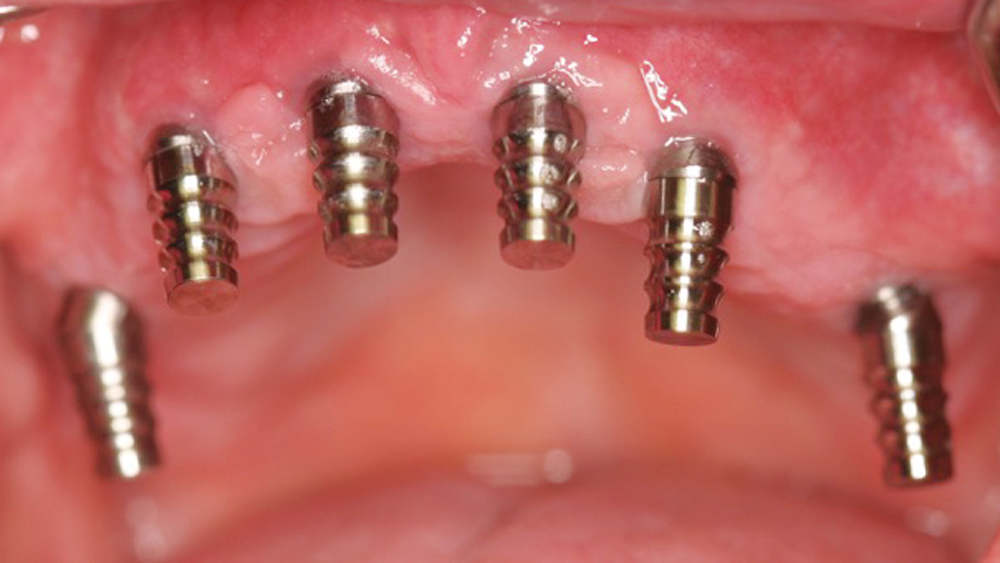
Figures 6a, 6b: After four months of healing, initial impressions were taken so the arches could be restored following a straightforward protocol similar to that of the traditional screw-retained acrylic hybrid denture. Note that the lower arch was restored prior to the upper arch in order to establish the proper plane of occlusion.

Figures 6a, 6b: After four months of healing, initial impressions were taken so the arches could be restored following a straightforward protocol similar to that of the traditional screw-retained acrylic hybrid denture. Note that the lower arch was restored prior to the upper arch in order to establish the proper plane of occlusion.
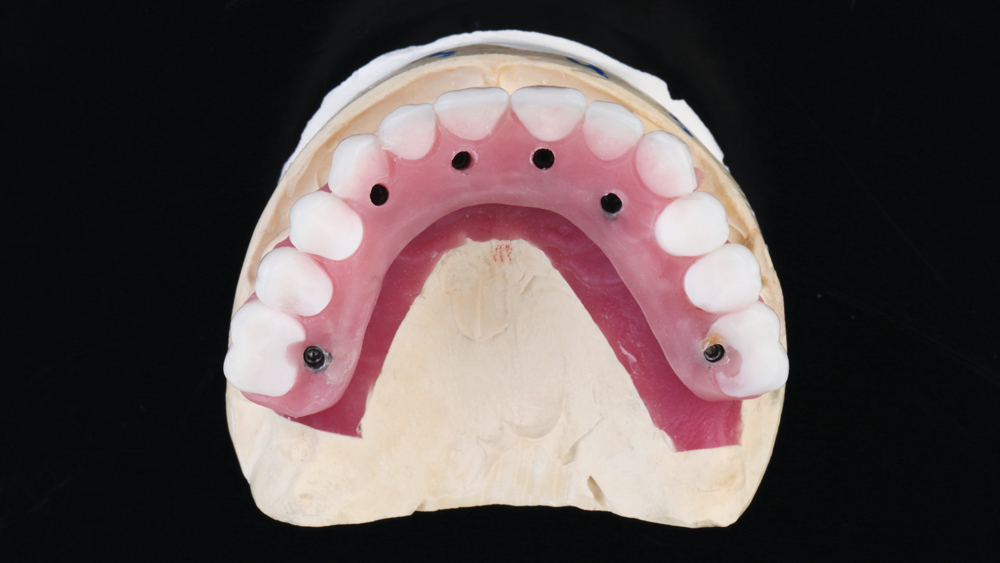
Figure 7: After recording the jaw relationship with wax rims, wax setups were produced by the lab and tried-in to evaluate fit, function, occlusion and esthetics.
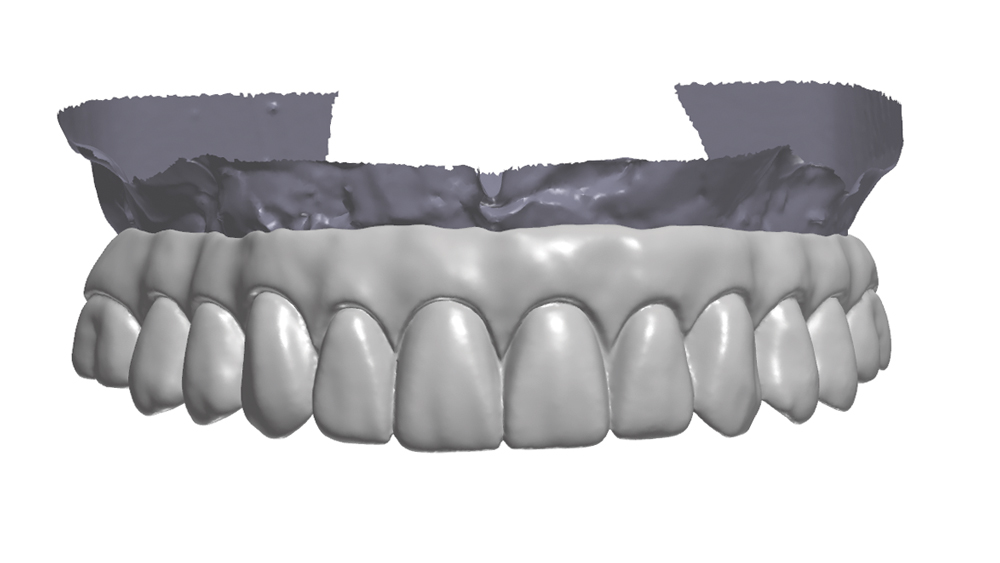
Figures 8a, 8b: After scanning the doctor- and patient-approved wax setups and master models, the dental lab used advanced dental CAD software to create the digital designs for the final BruxZir restorations.
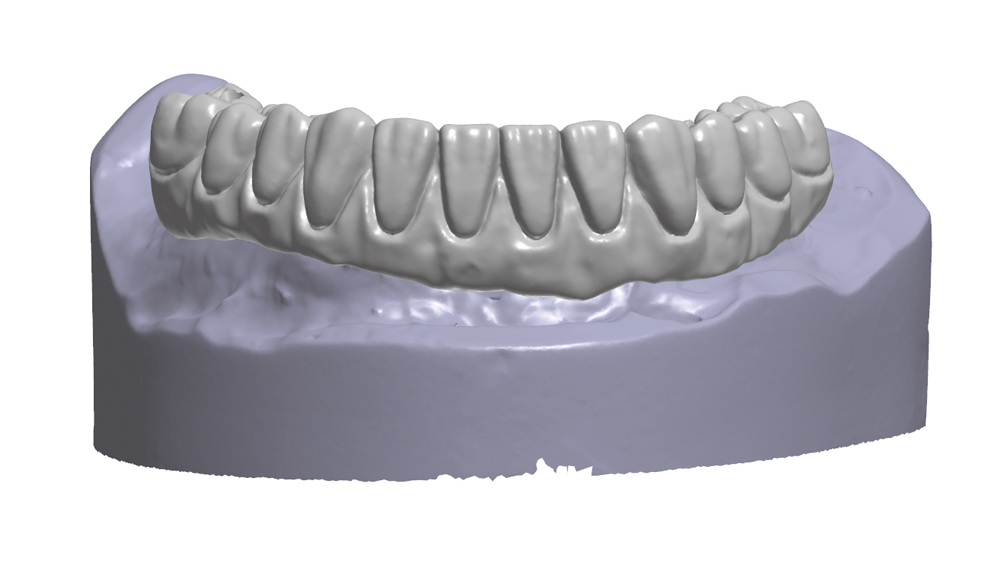
Figures 8a, 8b: After scanning the doctor- and patient-approved wax setups and master models, the dental lab used advanced dental CAD software to create the digital designs for the final BruxZir restorations.
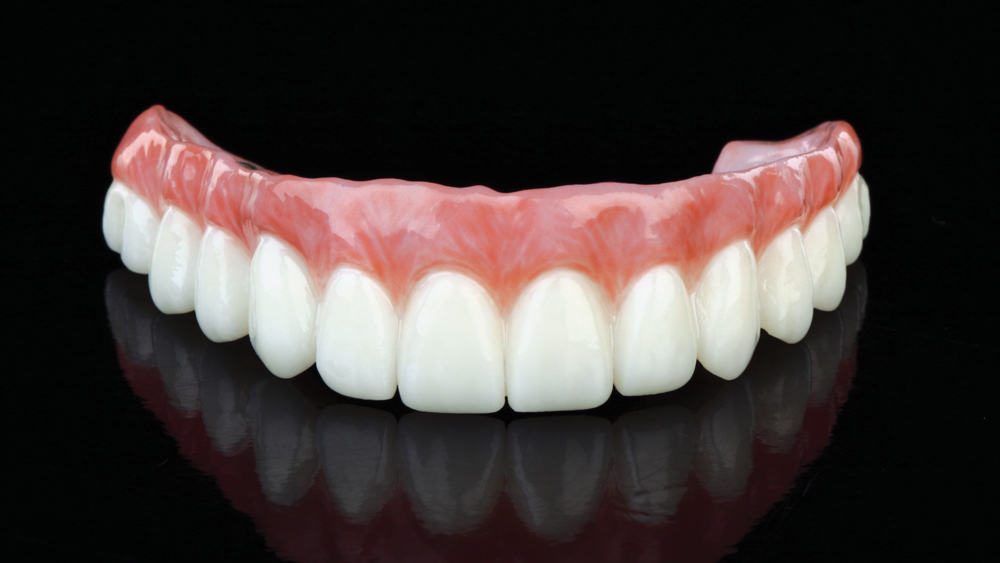
Figures 9a, 9b: The BruxZir Full-Arch Implant Prostheses were milled from a block of 100 percent solid zirconia. This monolithic construction is essential in avoiding the chips, fractures and other prosthetic complications that can shorten the lifespan of fixed acrylic hybrid appliances.
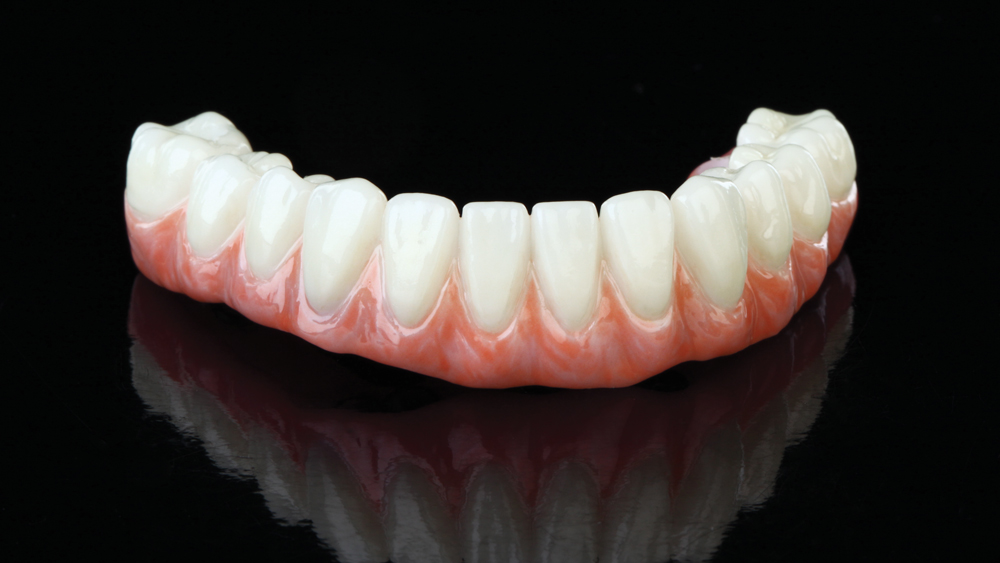
Figures 9a, 9b: The BruxZir Full-Arch Implant Prostheses were milled from a block of 100 percent solid zirconia. This monolithic construction is essential in avoiding the chips, fractures and other prosthetic complications that can shorten the lifespan of fixed acrylic hybrid appliances.
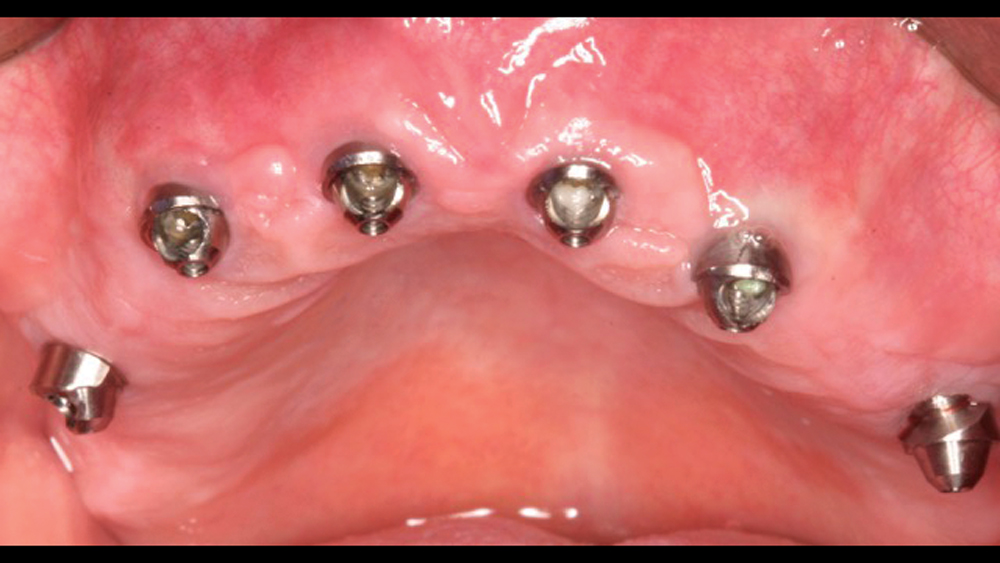
Figures 10a, 10b: Inclusive® Multi-Unit Abutments (Glidewell Direct) were used to establish a level restorative platform for the full-arch restorations.
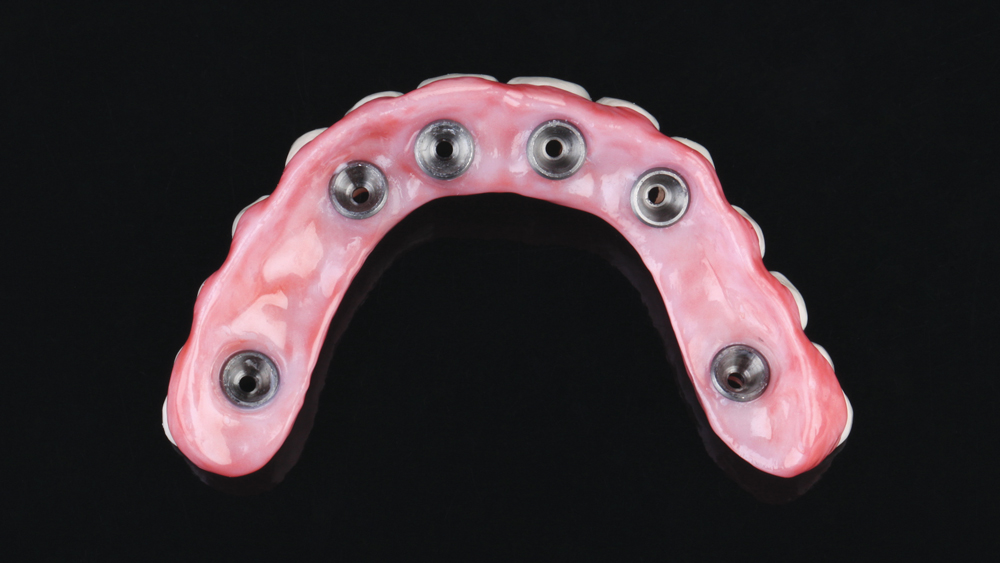
Figures 10a, 10b: Inclusive® Multi-Unit Abutments (Glidewell Direct) were used to establish a level restorative platform for the full-arch restorations.
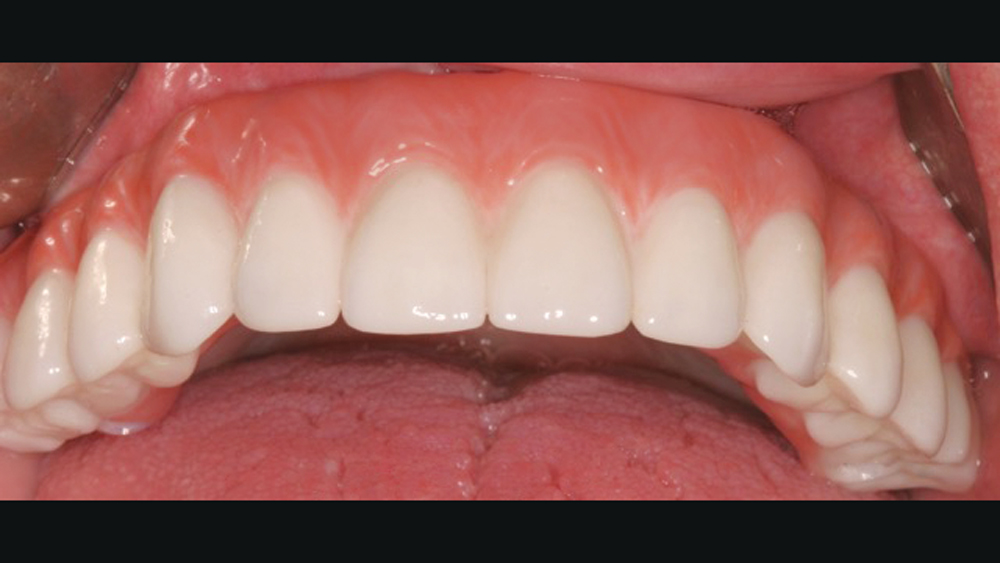
Figure 11: Each BruxZir Full-Arch Implant Prosthesis was tried in and established an accurate, passive fit upon seating. The prosthetic screws were then tightened, and the screw-access channels were sealed with Camouflage® NanoHybrid Composite (Glidewell Direct).
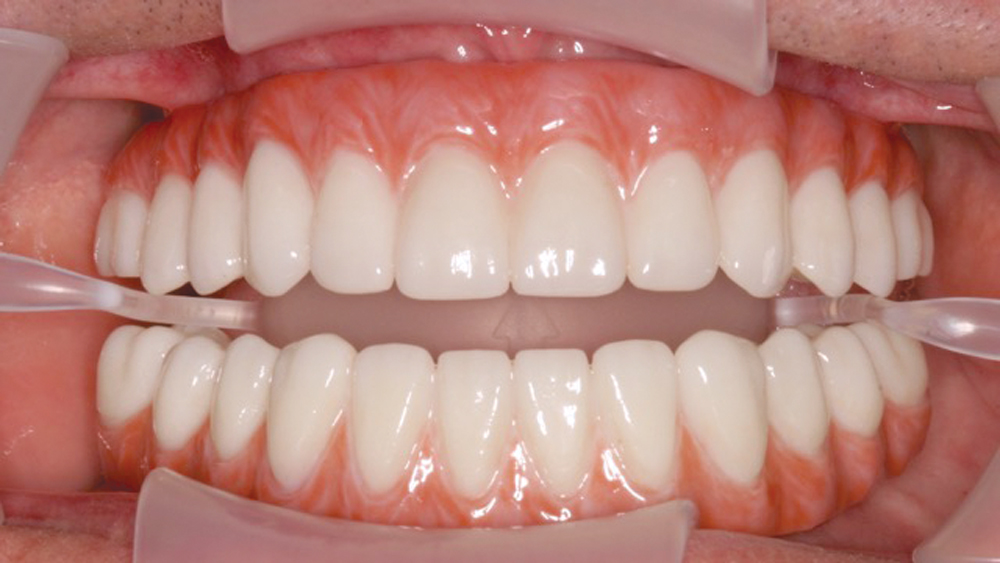
Figures 12a–12c: The patient was extremely pleased with the comfort, function and esthetics of the final restorations. With firmly integrated implants supporting monolithic zirconia prostheses, the patient enjoys an excellent long-term prognosis.
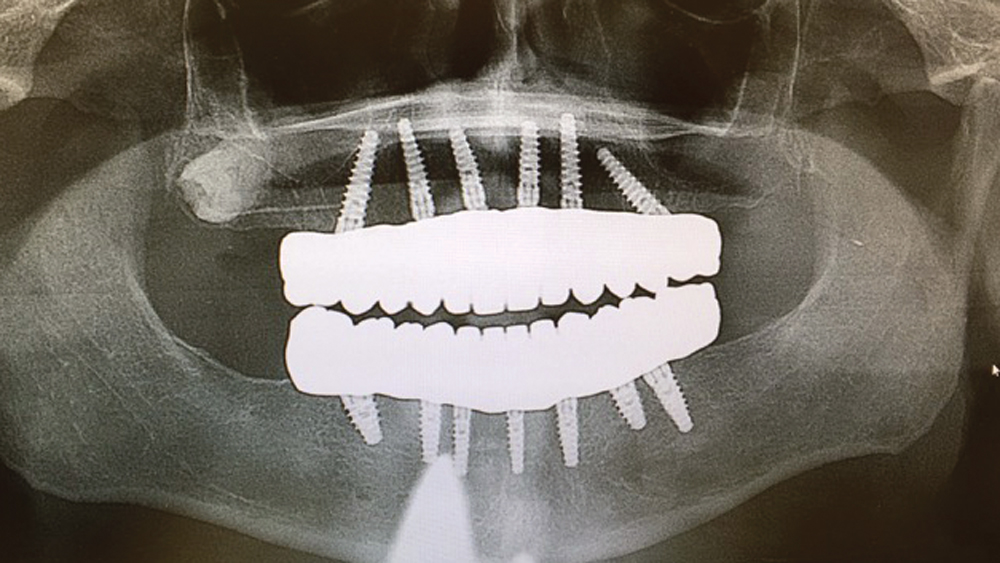
Figures 12a–12c: The patient was extremely pleased with the comfort, function and esthetics of the final restorations. With firmly integrated implants supporting monolithic zirconia prostheses, the patient enjoys an excellent long-term prognosis.
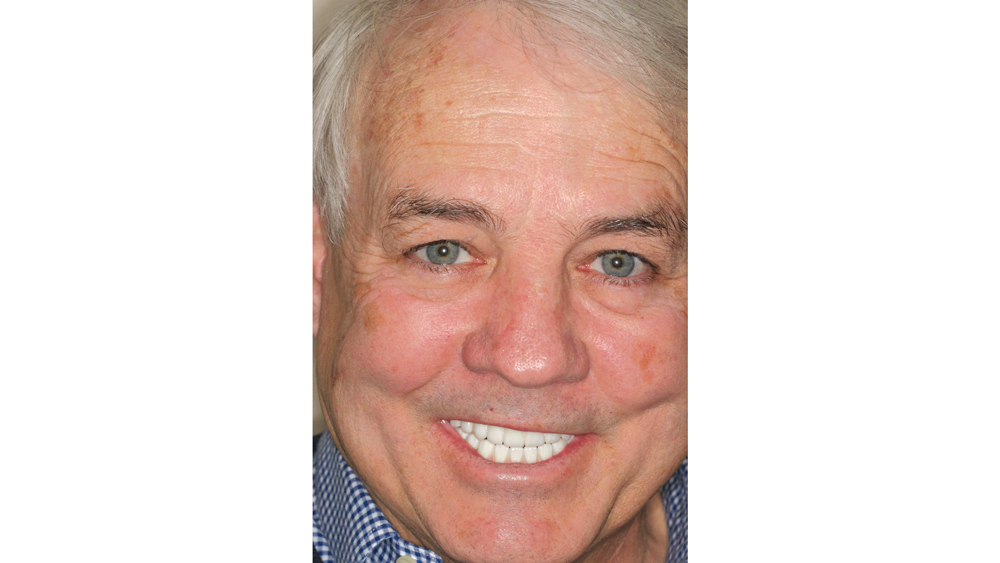
Figures 12a–12c: The patient was extremely pleased with the comfort, function and esthetics of the final restorations. With firmly integrated implants supporting monolithic zirconia prostheses, the patient enjoys an excellent long-term prognosis.
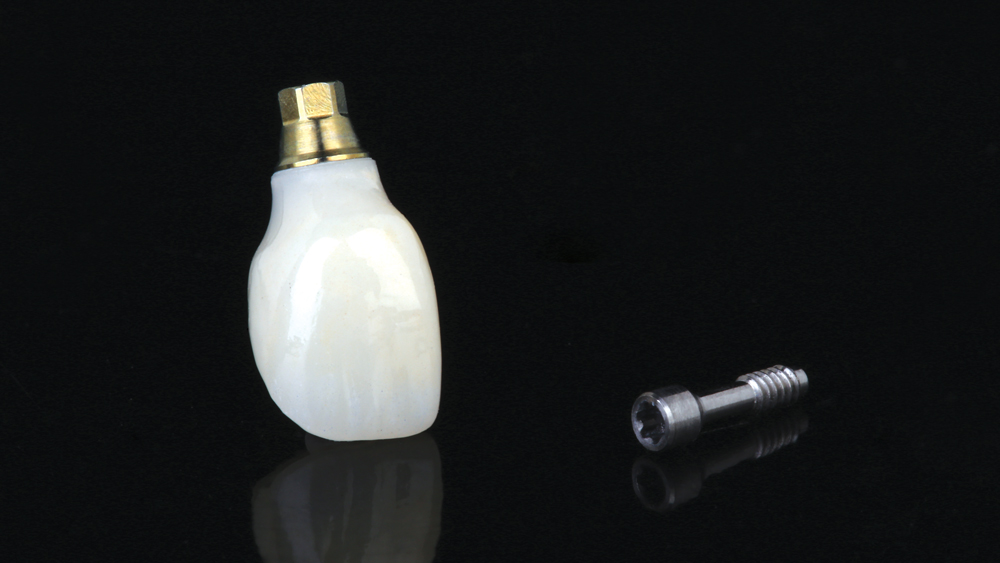
Figure 22: The final screw-retained crown was fabricated from BruxZir® Anterior Solid Zirconia, which was chosen for its combination of strength and lifelike esthetics.
- 1
- 12
- 21
CONCLUSION
For patients with adequate quantity and quality of bone, extraction with immediate implant placement is an efficient means of tooth replacement that reduces the number of surgical procedures and shortens the duration of treatment. In full-arch indications, this approach can deliver results that instantly transform dental form, function, personal confidence and quality of life. Achieving a predictable, long-lasting result has been simplified by innovations in implant design and prosthetics, making this an excellent option for practitioners providing implant therapy for their terminal dentition or edentulous patients.
References
- ^ Lee SY, Kim SJ, An HW, Kim HS, Ha DG, Ryo KH, Park KB. The effect of the thread depth on the mechanical properties of the dental implant. J Adv Prosthodont. 2015 Apr;7(2):115-21.
- ^ Abuhussein H, Pagni G, Rebaudi A, Wang HL. The effect of thread pattern upon implant osseointegration. Clin Oral Implants Res. 2010 Feb;21(2):129-36.
- ^ Larsson C, Vult Von Steyern P. Implant-supported full-arch zirconia-based mandibular fixed dental prostheses. Eight-year results from a clinical pilot study. Acta Odontol Scand. 2013 Sep;71(5):1118-22.
- ^ Pozzi A, Holst S, Fabbri G, Tallarico M. Clinical reliability of CAD/CAM cross-arch zirconia bridges on immediately loaded implants placed with computer-assisted/template-guided surgery: a retrospective study with a follow-up between 3 and 5 years. Clin Implant Dent Relat Res. 2015 Jan;17 Suppl 1:e86-96.



